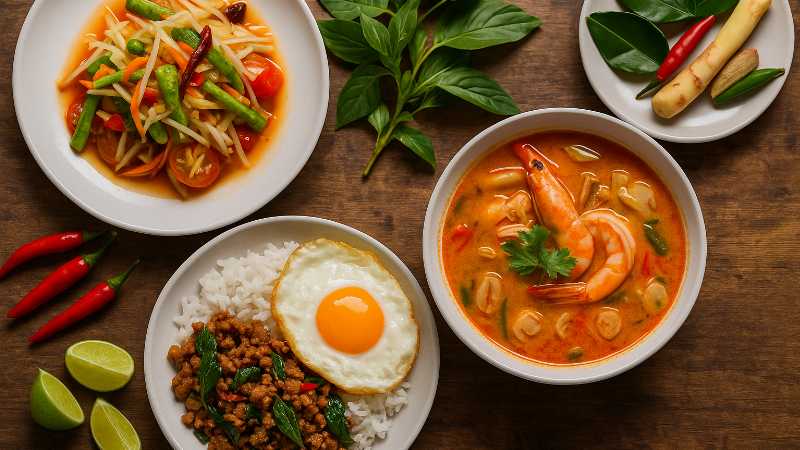
3 Thai Dishes Tourists Always Mispronounce
Food & DrinkOrdering Thai food can feel like a mini language lesson. You’re hungry, you point at the menu, and then mumble something that sounds like “sah-tayee with that paw-thaiyuh?”
The server smiles politely. You tried. But let’s get you closer to the real deal.
Here are three iconic dishes tourists love… and regularly butcher:
1. Som Tam (ส้มตำ)
What it is: Spicy green papaya salad — crunchy, fiery, sweet, and addictive.
How it’s usually pronounced: “Sohm Tahm,” “Some Tamm,” or just gestures vaguely at the menu.
How to say it: Sohm Tam
First word rhymes with “home,” second with “thumb.”
Bonus points if you can say “mai phet” (not spicy) — unless you want your eyebrows melted off.
2. Pad Kra Pao (ผัดกะเพรา)
What it is: Stir-fried holy basil with meat and rice — Thailand’s no-fail comfort food.
How it’s usually pronounced: “Pad Ka Pow,” “Pad Gra Prow,” “Pad Kapow” (like a cartoon punch).
How to say it: Pad Kra Pow
“Kra” is short and sharp, like “crab” without the b.
And yes, it comes with a fried egg (kai dao) unless you ask otherwise.
3. Tom Yum Goong (ต้มยำกุ้ง)
What it is: Spicy and sour shrimp soup, famous worldwide and famously bold.
How it’s usually pronounced: “Tom Yum Gong,” “Tom Yoom Goon,” “Tong Yom.”
How to say it: Tom Yum Goong
“Goong” means shrimp — it’s a nasal “ng” sound, like the end of “song.”
Say it right, and the waiter might actually give you a proud nod.
Why It Matters
Mispronouncing Thai food doesn’t make you a bad tourist — it just means you’re learning. And Thais genuinely appreciate the effort.
So next time, speak up with confidence… or just point and smile. Both usually work.
Pro tip: If they laugh, it’s not mean — it’s just charming. You’re officially part of the island now.
#ThaiFoodGuide #KohSamuiEats #SomTam #PadKraPao #TomYumGoong #ThailandTravelTips #SpeakLikeALocal #IslandFoodCulture #samuisocial

